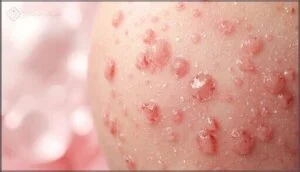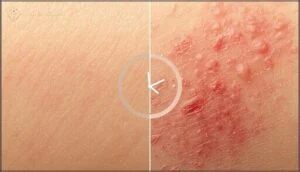This site is supported by our readers. We may earn a commission, at no cost to you, if you purchase through links.
Your skin doesn’t need much of an excuse to revolt. A new necklace, a different laundry detergent, even that “hypoallergenic” lotion—any of these can trigger an immune response that leaves you scratching, red, and miserable. Nearly one in five children with atopic dermatitis reacts to nickel alone, and that’s just one of dozens of potential culprits hiding in everyday products.
The good news is that managing skin allergies isn’t about living in a bubble. It’s about recognizing your triggers, knowing which remedies actually work, and building a skincare routine that keeps your skin calm instead of constantly fighting back. Once you understand what sets off your reactions, you can take back control.
Table Of Contents
Key Takeaways
- Your skin allergies become manageable once you identify your specific triggers—nearly one in five children with atopic dermatitis reacts to nickel, while fragrances affect 4.4% of allergy sufferers, so pinpointing what sets off your reactions gives you real control.
- Home remedies like cool compresses and colloidal oatmeal baths provide quick relief without pharmacy trips, while choosing strictly fragrance-free products (not just “unscented”) prevents up to 4.5% of adult reactions caused by hidden irritants.
- Seek immediate medical care if you experience throat swelling, breathing difficulty, or dizziness—these anaphylaxis symptoms require urgent treatment—but see a dermatologist for any rash lasting over a week or showing signs of infection.
- Long-term management requires creating an allergen-free environment with HEPA filters and dust-mite-proof covers, while tracking symptoms through a diary or biosensor apps helps you spot patterns and prevent flare-ups before they worsen.
Recognizing Skin Allergy Symptoms
Your skin is often the first to sound the alarm when something doesn’t agree with you. Recognizing what’s happening early can help you take control before symptoms get worse.
Here’s what to watch for and when it’s time to reach out for professional help.
Common Signs of Skin Allergies
Skin allergy symptoms vary widely, but certain signs appear consistently. Itching ranks as the most common complaint, affecting over 80% of patients with atopic dermatitis. You may also notice redness, swelling, or rashes that develop within hours of allergen exposure.
Watch for these key indicators:
- Persistent itching that disrupts sleep or daily activities
- Raised, red bumps or hives appearing suddenly on your skin
- Localized swelling around the affected area
- Dry, flaky patches that worsen with repeated exposure
- Blisters or cracked skin in severe allergic reactions
Recognizing these patterns helps you identify allergic reactions early and take control of your skin health. Understanding skin allergy causes is essential for effective management and treatment.
Differentiating Allergic Reactions From Other Rashes
Not every rash signals an allergic reaction. Timing offers your first clue—allergic skin reactions usually appear within minutes to two hours after exposure, while other rashes develop more gradually.
Look for raised hives or welts, which occur in nearly 69% of allergic cases. If you’re uncertain, patch testing or skin biopsy can confirm whether immunological response drives your symptoms, distinguishing allergic dermatitis from irritation or infection.
Understanding skin allergy causes is vital for effective management and treatment.
When Symptoms Require Medical Attention
Most skin allergies settle on their own, but certain warning signs demand immediate medical intervention. Seek emergency care if you notice swelling of your face or throat, difficulty breathing, or dizziness—these anaphylaxis symptoms appear within minutes and require urgent treatment.
Contact your doctor if rashes persist beyond a few days, show signs of infection, or rapidly spread. Seeking medical advice promptly can prevent severe complications from progressing.
Identifying and Avoiding Allergy Triggers
Once you know what you’re reacting to, managing your skin allergies becomes much easier. The key is learning which substances are causing your symptoms and then taking practical steps to avoid them.
Let’s look at the most common culprits and how to keep them off your skin.
Common Skin Allergens to Watch For
You can’t sidestep what you don’t recognize. Understanding which substances trigger skin allergies gives you real control over flare-ups. Many everyday items contain hidden allergens that cause allergic contact dermatitis or irritant contact dermatitis. Here’s what to watch for:
- Nickel Allergy – Found in jewelry and belt buckles, affecting 19.3% of children with atopic dermatitis
- Fragrances – Present in lotions and perfumes, causing fragrance reactions in 4.4% of cases
- Latex Sensitivity – In gloves and elastic, triggering reactions in 7.3% of allergy sufferers
- Plant Allergens – Poison ivy oils cause severe contact dermatitis
- Formaldehyde preservatives – Hidden in personal care products, linked to increasing metal toxicity concerns
Preventing Cross-Contamination and Allergen Exposure
Once you’ve spotted your allergy triggers, keeping them at bay becomes your next mission. Hand hygiene matters most—wash with warm, soapy water after potential allergen exposure, as hand sanitizers won’t cut it.
Use protective gear like gloves when handling known irritants. Clean surfaces with commercial detergents to guarantee allergen removal.
These environmental controls strengthen your skin barrier and prevent flare-ups in sensitive skin.
Effective Home Remedies for Skin Allergies
When your skin starts to flare up, you don’t always need to run to the pharmacy. Several simple remedies you can use at home offer real relief from itching and inflammation.
Here’s what actually works when you need quick comfort.
Using Cool Compresses and Oatmeal Baths
When allergic skin flares up, simple cold therapy benefits can offer quick relief. Apply a cool compress for 15-20 minutes to numb itch and reduce swelling.
For broader skin irritation, colloidal oatmeal baths provide natural soothing remedies with anti-inflammatory properties. Regular oatmeal skin relief helps manage symptoms and decreases steroid dependence.
These itch management tips effectively support allergy symptom alleviation at home.
Applying Anti-Itch Creams and Moisturizers
Relief starts with the right topical treatment options. Apply hydrocortisone 1% or calamine lotion to reduce itching within days. For itch relief strategies, non-steroid anti-itch cream options like pramoxine work well on sensitive skin.
Moisturize twice daily to support skin barrier repair and prevent flare-ups. Choose ointments for thick patches and lotions for larger areas. These cream application tips deliver moisturizer benefits that control symptoms effectively.
Choosing Gentle, Fragrance-Free Skincare Products
Your skin deserves products that protect rather than provoke. Up to 4.5% of adults react to fragrances in skin care products. Choose hypoallergenic choices labeled strictly “fragrance-free” instead of “unscented.”
These gentle product options support sensitive skin care by reducing inflammation and strengthening your natural barrier. Natural skincare doesn’t always mean safe—essential oils can trigger reactions too.
Gentle, fragrance-free products protect sensitive skin, but natural doesn’t guarantee safety—essential oils can still trigger reactions
The fragrance-free benefits include fewer breakouts and lasting comfort.
Medical Treatments and Professional Care
When home remedies aren’t enough to manage your symptoms, it’s time to think about medical treatments. Your healthcare provider can prescribe stronger medications or recommend specialized testing to pinpoint your specific triggers.
Let’s look at the treatment options available and when professional care becomes necessary.
Over-the-Counter and Prescription Medications
When symptoms persist, medication can offer real control. OTC allergy medications like cetirizine or loratadine work well for mild reactions, while topical treatments such as hydrocortisone cream reduce itching effectively. Antihistamine efficacy varies, but second-generation options minimize drowsiness.
For severe cases, prescription options include stronger corticosteroids, though corticosteroid risks like skin thinning require monitoring. Long-term usage demands caution—adverse reactions can occur, especially after abrupt cessation of antihistamines.
When to See a Dermatologist or Allergist
When should you hand things over to the experts? See a dermatologist if your rash persists beyond a week, spreads rapidly, or develops blisters. Dermatologist referrals help with chronic conditions needing medical diagnosis.
Allergist consultations make sense for recurring reactions, food sensitivities, or when specialist care can pinpoint hidden triggers.
A skin emergency—like throat swelling or fever—demands immediate attention.
Long-Term Skin Allergy Management
Managing skin allergies doesn’t end once symptoms clear up. Long-term control means building habits that protect your skin and reduce future flare-ups.
Here’s how to create lasting relief through your environment, lifestyle choices, and daily monitoring.
Creating an Allergen-Free Environment
To achieve lasting allergy relief, you need to tackle allergen removal at its source. Start by encasing mattresses and pillows in dust-mite-proof covers and washing bedding weekly in hot water.
Use HEPA-filter vacuums for dust reduction and keep pets out of your bedroom to minimize pet dander.
Air purification systems help filter airborne allergens, while maintaining closed windows during pollen season aids allergen avoidance and reduces allergy triggers.
Adopting Supportive Lifestyle and Dietary Changes
Beyond clearing your space of allergens, your daily choices play a powerful role in managing skin allergy symptoms. Simple dietary adjustments and stress management can bring real allergy relief.
Consider these supportive changes:
- Add omega-3-rich fish and quercetin-packed berries for natural remedies that calm inflammation
- Stay hydrated—proper hydration tips include drinking water throughout the day to strengthen your skin’s defense
- Incorporate light physical activity and nutrient therapy with magnesium-rich almonds
These dietary changes support healthier skin care from within.
Monitoring Skin Health and Preventing Flare-Ups
Tracking your skin health helps you spot patterns before flare-ups take hold. Wearable biosensors and AI-driven apps now offer accurate flare prediction and allergen alerts. You’ll notice subtle changes—like increased dryness or itching—that signal trouble ahead.
Keep a simple symptom diary to identify your triggers. These health monitoring and prevention strategies give you control over skin allergies rather than reacting after symptoms worsen.
Frequently Asked Questions (FAQs)
Can stress trigger or worsen skin allergies?
Stress acts like gasoline on a fire regarding skin allergies. Your immune system shifts gears under pressure, triggering inflammation and weakening your skin’s protective barrier.
Studies show up to 70% of people with eczema report stress worsens their symptoms.
Are skin allergies hereditary or genetic?
Yes, skin allergies are hereditary. Genetic mutations, especially in the FLG gene, strongly influence your risk.
If one parent has atopic dermatitis, your child’s likelihood triples. Both parents affected? Risk increases fivefold.
How long does patch testing typically take?
Like waiting for bread to rise, patch testing unfolds gradually over about a week. You’ll wear the patches for 48 hours, then return for readings at days two and four to detect delayed reactions.
Can you outgrow skin allergies over time?
Many children outgrow skin allergies as their immune system matures and develops tolerance. Roughly 80% of kids with eczema see improvement by age eight.
However, some allergies persist into adulthood depending on severity and allergen type.
Do seasonal changes affect skin allergy severity?
Seasonal changes markedly impact skin allergy severity. Temperature fluctuations and pollen exposure disrupt skin barrier function during transitions.
Summer-born patients experience peak eczema symptoms in summer, while cold, dry winter air worsens dryness and cracking.
Conclusion
The difference between constant flare-ups and clear skin often comes down to one thing: knowing what to avoid and when to act. These tips for managing skin allergies give you the framework to identify triggers, calm reactions quickly, and prevent future episodes.
You don’t need perfect conditions—just consistent habits and the right interventions. Your skin can stop fighting back when you give it the support it needs.
- https://acaai.org/allergies/allergies-101/facts-stats/
- https://pmc.ncbi.nlm.nih.gov/articles/PMC12167089/
- https://www.aaaai.org/about/news/for-media/allergy-statistics
- https://allergyasthmanetwork.org/allergies/allergy-statistics/
- https://www.mayoclinic.org/diseases-conditions/contact-dermatitis/symptoms-causes/syc-20352742











